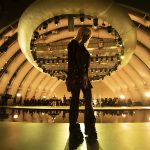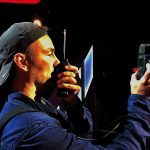LD Joshua Hutchings brings a classic feel to Match Game on ABC
ABC has gone back into the game show business, and they are doing it in a big way. They have four “new” game shows on the docket for this summer and, while many are new to ABC, many Americans will instantly remember these as classic shows from the 1970s and ‘80s. The re-launched game show lineup includes $100,000 Pyramid, Celebrity Family Feud, To Tell the Truth and Match Game. Perhaps the biggest update from the past versions of these beloved shows is that they will be aired in prime time.

Previously a staple of daytime TV, the primetime slots should bring an edgier sensibility to the interaction of the contestants and celebrities. Having Match Game air at 10 p.m. will certainly make it easier for host Alec Baldwin and the panel of six celebrities to cut loose in a game whose format is an ideal playground for quick wit to meet bawdy innuendo.
Produced by FreemantleMedia North America, Match Game, which premiered on Sunday, June 26 to positive reviews, is shot on the Upper West Side of Manhattan at ABC Studios. Echoing the much loved format of the show, the throwback-style set by production designer Anton Goss was lit by lighting designer Joshua Hutchings, principal of Mission Viejo, CA-based Illumination Advocates. PLSN spoke with Hutchings about his approach balancing the very popular show’s iconic look with a modern lighting aesthetic and his family connection to the original Match Game.
How different is this version from the much loved 70’s version?
Joshua Hutchings: When the executive producers first approached me and we started talking about the concept of the show, they really wanted the look and feel of the original 1970’s game show. The original show was so loved, everyone recognized that and we didn’t want to change things just to change things. It was certainly a favorite of mine and, actually, my stepfather won $20,000 on Match Game back in 1979! I think that Anton [Goss] did a really great job with this set, and his production design really gave us great direction. From a technical and visual standpoint, it all started with Anton setting the tone. This new version of the show really pays homage to the original in every aspect. Right down to the carpet. Somehow, I don’t know where, but Dylan Jones, the art director, managed to find a batch of original, to-the-period, orange three-inch shag carpeting!
So the overall design concept was really driven from the desire to maintain that original look but, having said that, it is now a 10PM game show. We consciously wanted the show to have a more late-night feel, a little more adult; they didn’t necessarily want the old-style game show light levels of 300-footcandles. I’ve tried to find balance of a little shadowy, a little darker, and feel a little more nighttime without getting into a ton of beams. It’s a classic game show, but done with new technology.
What level are you lighting for your design?
I was planning to shoot for about 30 footcandles. When you lower the footcandles, the depth of field gets tighter for the cameras, and because it’s not a very deep set, getting the backgrounds slightly out of focus gave it more depth. We ended up shooting at 35 footcandles, and we had a nice level of the depth of field with our cameras so the backgrounds went fuzzy where we wanted them to.
What are the key areas that you have to light on this set?
We have three home bases that we’re concerned about — our contestant area; our celebrity panel area; and we have our host, Alec Baldwin, who can go anywhere. So there are the knowns and then there are the unknowns. For the most part, Alec will kind of hang out in between the celebrities and the contestants. But if he decides to go anywhere else around the set, he has that prerogative; and I needed to be prepared for that possibility. The set is relatively small, so it is limiting more to where they can put the cameras than the lighting.
Are you lighting the audience?
It’s not planned that they will play a significant part in the flow of the show, but I wanted to be sure Alec could go in the audience, so you need to be prepared for that possibility. On this show, we have a relatively low roof; we’re in a studio with a 17-foot tall trim, so trying to cover large flat areas cleanly without getting a lot of buildups or drop-offs, and not have it look area-lit, is an issue. Trying to maintain carved out sections with a low trim and maintaining intensity across everybody evenly was a challenge on this one.
What was your plan going into taping, and how did it all turn out?
Because of the proximity between the contestants and the set walls, we wanted to avoid having a big wash. We really wanted to carve out all of the areas and avoid a lot of wash onto the set. We went with a lot of ellipsoidals as opposed to a lot of television Fresnels. We carved out every section while trying to smoothly combine 35-40 ellipsoidals as opposed to carpet bombing with a bunch of Fresnels.
The producers commented, “If they were to walk out of light, it’s okay. It’s nighttime,” and so I have given them their zones, and when they move through them, it feels real. That was original intent, and we have stayed with that approach. So there are times when they stand up or move towards the audience, and it’s okay for them to come out of light a little bit. I felt that as long as they were moving between locations, a small drop of intensity was good, provided they were clean when they stopped. Having this approach allowed us to not over-light everything, which would have really blown out the set.
What are some of your key equipment choices?
I’m using Clay Paky Mythos overhead to basically create what I like to think of as our ceiling piece, and make it look like we don’t have as low of a ceiling as there really is there. I am trying to create almost a lightbox effect with beams, trying to create a feeling of an infinite space without revealing our true height. That is the thought process for that part of the design. I think that it worked out quite well, on the wide shots we created an artificial ceiling, as opposed to seeing the pipe grid.
So Mythos are there overhead, as well as on the ground outlining the set. There is quite a lot of LED ribbon installed on the set, and I’ve got 80 some-odd [Philips Color Kinetics] ColorBlasts uplighting walls around the set. I’ve got Martin Rush PAR 2 Zooms for audience backlights, and for color and heat in the audience, and our complement of [ETC] Source Four ellipsoidals, also some 2kW Fresnels and 1kW Fresnels. All of the standard go-to conventional television fixtures. All of the keying being at a tungsten color temperature.
Why did you choose to go with 3,200K color temperature?
Well, the primary reason why I went tungsten is because the set is orange. The majority of the background and the majority of the set pieces are covered with MR16s and MR11s in and around the set. Also, our main background signage is incandescent. Rather than going away from incandescent, going arc or daylight, I didn’t want to compete. The LED ribbon and the LED options we have can do incandescent better than trying to color balance up other incandescents.
What colors are you using in your LED ribbon tape in the set?
I’m using RGBA LED ribbon in the set. We already have the warm white, and when shooting at 3,200K, we still have good separation of all our blues. I wanted to get a good contrast to all the incandescents in the sets. All the set highlights can go blue and magenta, and we have the color separation on the cameras so that it all just doesn’t look too blue as if we were using more daylight lighting.
Tell us about your team on Match Game.
I worked with Tim Murch out of PRG in Los Angeles They supplied the lighting; Tim goes out of his way to support not just the production companies but lighting designers. My programmer is Tiffany Keys, who did a fantastic job, she brings a perfect blend of great skill and incredible work ethic, even though we were freezing all day in the studio! My gaffer is Trevor Gooch, who was real asset to have, leading the crew through the load-in and shoot schedule. It was nice to having his second opinion with all the challenges on the show. We also had a great IATSE Local 1 crew, led by house head Sean Ryan. In general, it was a great collaboration between all the departments.
It must be fun to get to work on the show.
Everyone was having so much fun with the show, it almost didn’t feel like work! The energy in the studio is really great. This is a very free-flowing show, and it feels like a bunch of friends getting together, laughing their asses off. It’s a hell of a lot of fun.
Match Game airs Sundays at 10PM EDT/9PM CDT on ABC.


